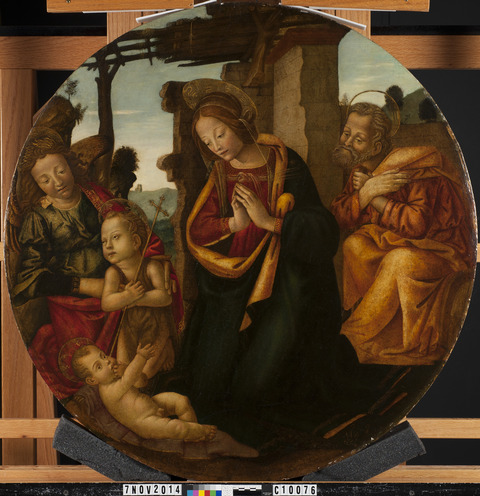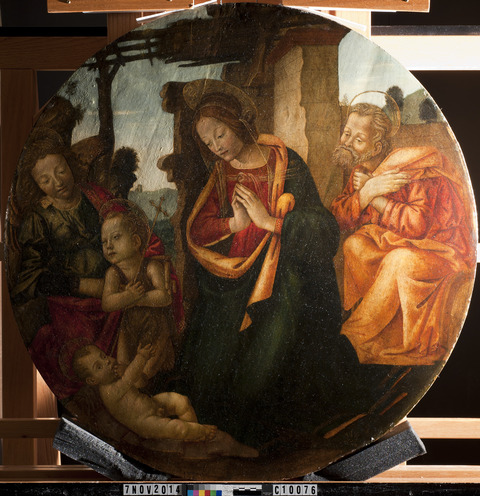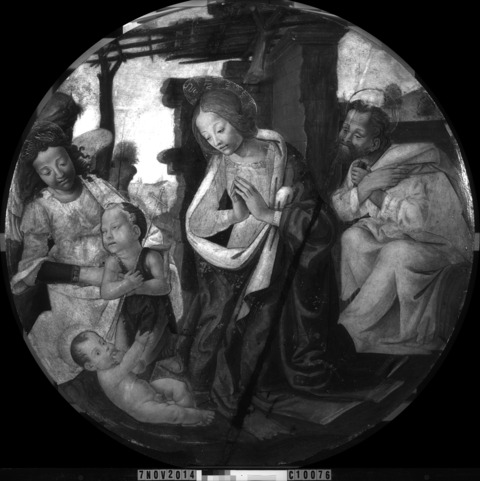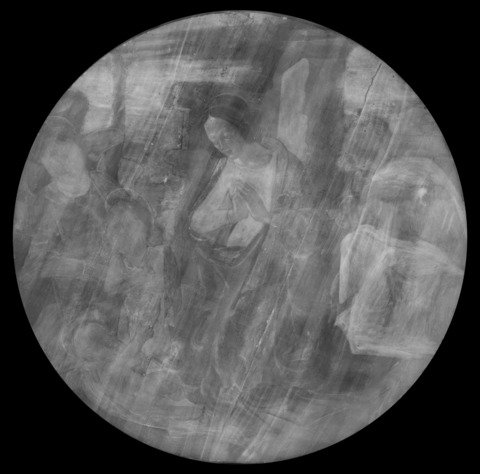Overview
Identification number: 2015.30
Artist: Workshop of Bastiano Mainardi
Title: Adoration of the Christ Child
Materials: Egg tempera and oil [confirmed] on poplar panel
Date of creation: 1490–1500
Previous number/accession number: C10076
Dimensions: 84.7 × 83.8 cm
Conservator/examiner: Fiona Beckett and Roxane Sperber
Examination completed: 2015, revised 2020
Distinguishing Marks
Front:
None
Back:
None
Summary of Treatment History
There are no recorded treatments to the painting before it was permanently loaned to the Indianapolis Museum of Art (IMA) by the Clowes Fund in 1971. However, physical alterations on the painting suggest a long treatment history. There is a thick, discolored varnish on the painting’s surface, several campaigns of discolored retouching, and extensive passages of overpaint, particularly in the sky and robes of the Madonna. The paint layer shows significant abrasion, likely from previous cleaning interventions, and there are losses along the joins in the panels that have been filled and retouched. Evidence of further structural intervention, in the form of a substantial cradle, is also present on the back. The back and cradle have been coated in a thick, waxy coating.
Documentation suggests a series of condition assessments and treatments were carried out on the collection about the time the works were moved from the Clowes residence to the IMA in 1971. A condition report by Paul Spheeris in October of that year, likely carried out before the paintings were relocated, described the frame as having a small scratch and some drips. He recommended cleaning the painting for the sake of its appearance but not for the stability of the paint layer.1 A second condition assessment was carried out upon arrival of the paintings at the IMA. This assessment describes the work as in good condition and no treatment was deemed necessary.2
In 1974, a condition assessment, treatment, and investigation of the collection was carried out by the Intermuseum Conservation Association at Oberlin College. Their report described this painting as having a darkened, yellowed natural resin varnish and a surface coating with restoration paint. Removal of the varnish and overpaint, as well as revarnishing and inpainting losses, was recommended.3 However, this treatment does not appear to have been undertaken.
In 1996, a memorandum summarizing treatment and examination of the Clowes Collection from the time it entered the Museum suggests that a “minor treatment” was performed in 1979.4 The painting was previously examined and documented in the Clowes Collection annual survey from 2012 to 2020.
Current Condition Summary
Aesthetically, the painting is in poor condition. It suffers from age cracks, discolored varnish, and significant passages of discolored retouching and overpaint. The painting is physically sound, with previous structural interventions intact.
Methods of Examination, Imaging, and Analysis
| Examination/Imaging | Analysis (no sample required) | Analysis (sample required) |
|---|---|---|
| Unaided eye | Dendrochronology | Microchemical analysis |
| Optical microscopy | Wood identification | Fiber ID |
| Incident light | Microchemical analysis | Cross-section sampling |
| Raking light | Thread count analysis | Dispersed pigment sample |
| Reflected/specular light | X-ray fluorescence spectroscopy (XRF) | Fourier-transform infrared spectroscopy (FTIR) |
| Transmitted light | Macro X-ray fluorescence scanning (MA-XRF) | Raman microspectroscopy |
| Ultraviolet-induced visible fluorescence (UV) | ||
| Infrared reflectography (IRR) | Gas chromatography–mass spectrometry (GC-MS) | |
| Infrared transmittography (IRT) | Scanning electron microscope -energy dispersive X-ray spectroscopy (SEM-EDS) | |
| Infrared luminescence | Other: | |
| X-radiography |
Technical Examination
Description of Support
Analyzed Observed
Material (fabric, wood, metal, dendrochronology results, fiber ID information, etc.):
The painting is a circular (tondo) panel composed of three wood planks with the grain on a diagonal in relation to the orientation of the painting composition (tech. fig. 1). All three members of the panel are cut in slightly varying tangential orientations. It is impossible to see the joins from the back of the panel due to a large cradle that is covered with a thick wax coating. A layer of canvas is visible at the edges of the painting, suggesting the canvas is present over the seams, which is consistent with fifteenth-century Italian panel-preparation techniques. The wood was identified as Salicaceae, willow/poplar type, which was common in Italian painting materials of the period.5
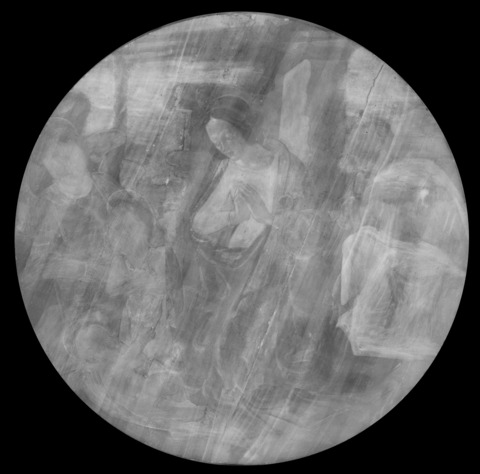
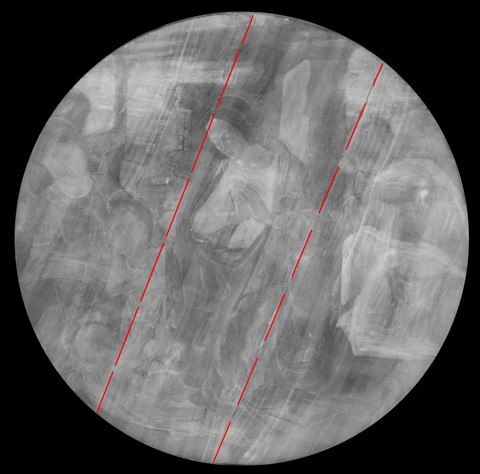
Characteristics of Construction / Fabrication (cusping, beveled edges of panels, seams, joins, battens):
The panel is constructed from three members, joined by glue (likely casein or animal glue) (tech. fig. 1). The panel would have been sized, and a layer of fabric added to the seams—some of the thin fabric can be seen along the painting’s edges, with layers of gesso applied on top.
Thickness (for panels or boards):
Varying thickness, 1.9–3.6 cm thick (4.2–5.7 cm with cradle)
Production/Dealer’s marks:
None
Auxiliary Support:
Original Not original Not able to discern None
The cradle has 12 fixed members and 11 movable members, which were immobilized by the application of a thick coating of a waxy substance (~0.3 cm) (tech. fig. 2). The cradle is fitted to the panel in the same orientation as the wood grain, resulting in a diagonal orientation when the painting is viewed upright. On the areas of the joins, larger cradle battens are used than those in the rest of the cradle, likely to provide more support in these areas.
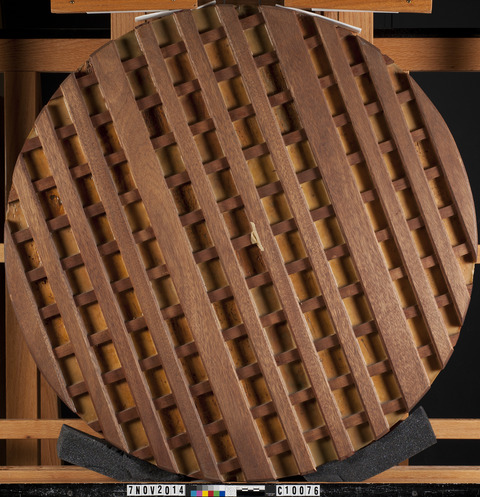
Attachment to Auxiliary Support:
The cradle appears to be attached to the original panel with glue. A thick coat of a waxy substance was subsequently applied to the back.
Condition of Support
The panel is currently in stable condition and remains relatively in plane with slight convexity. The panel was likely thinned before the addition of the cradle to provide an even surface for attachment. Because of a slight curvature in the panel, the work now varies in thickness, ranging from 1.9 to 3.6 cm. Slight wear is present around the edges, including overall nicks and dents. It appears that the edges of the panel were filed down during the conservation campaign in which the cradle was added. The file marks on the edge of the cradle are in the same orientation as those on the edge of the panel. The painting has a slight convexity in each of the three sections. It is difficult to see the actual panel members from the back due to the thickly applied waxy substance. A significant amount of woodworm tunneling is present. The back of the panel was thinned, and several gouge marks can be seen on the sides. This is particularly evident where the waxy coating is especially thick to fill these losses. The fabric component of the support is present in some areas along the edges, but it appears to have been worn away at the time the panel was filed.
Description of Ground
Analyzed Observed
Materials/Binding Medium:
A cross section of the ground (tech. fig. 3) was analyzed using SEM-EDS. The composition of the ground was confirmed to be calcium sulfate (tech. figs. 5, 6). The use of calcium sulfate (gesso) is consistent with Italian paintings of this period.
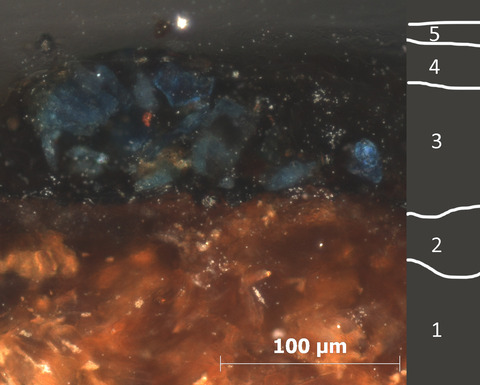
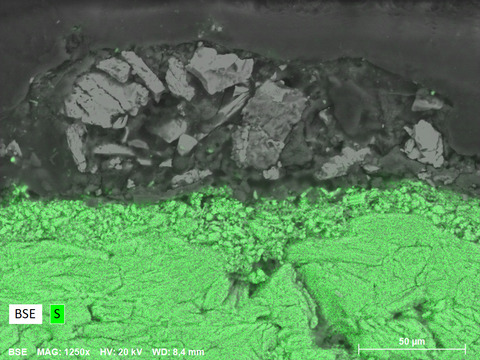
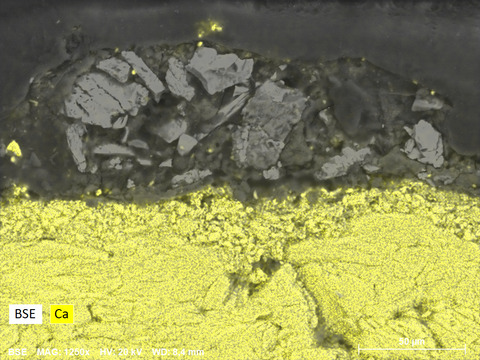
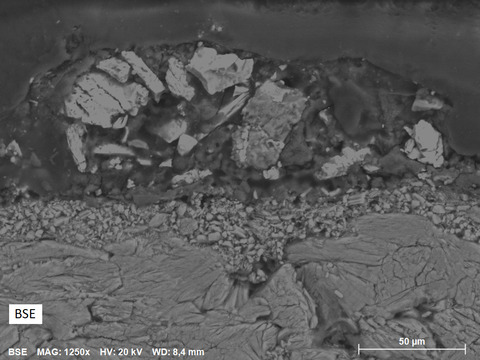
Color:
The ground is an off-white color where visible in the cracks and edges of the panel and seems to have slightly yellowed over time (tech. fig. 7).
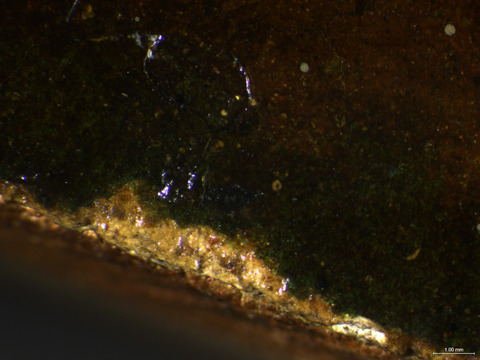
In fills that were added to areas of loss around the panel edges, the ground appears to be bright white (tech. fig. 8).
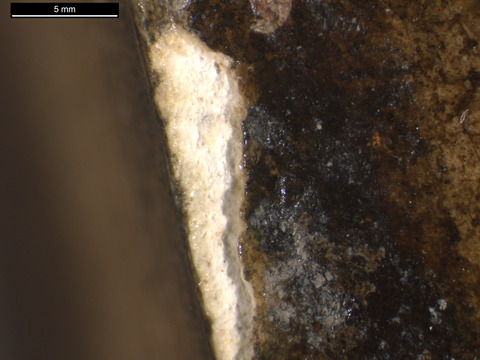
Application:
The ground was applied smoothly over the surface with a large brush. The BSE image shows that the ground was applied in several layers with varied texture, as was the practice of Italian workshops of this period (tech. figs. 4, 5). The more coarsely textured gesso grosso (tech. fig. 4, layer 1) was applied first followed by the finer gesso sottile (tech. fig. 4, layer 2). The ground texture is slightly visible on the panel when imaged with raking light.
Thickness:
As recommended by fifteenth-century artist Cennino Cennini, the courser gesso grosso was applied first in a thick layer, which is several hundred microns thick in cross section, followed by the finer gesso sottile layer, which is approximately 20 microns thick (tech. fig. 4).6
Sizing:
While not visible, animal-glue size would have been applied to the panel prior to the ground layer.
Character and Appearance (Does texture of support remain detectable / prominent?):
The wood grain remains visible through the ground and paint layers.
Condition of Ground
The ground appears to be in stable condition and is well adhered to the panel. The adhesion between the ground and the paint layer is also intact. Losses in the ground are visible in the X-radiograph along the right panel join, in the sky, and at the top of the panel. Losses are also present around the edges where some of the original ground is missing, likely related to the addition of the cradle as well as contact with the frame. White fills have been added to some of these areas of loss (tech. fig. 8) and are much brighter than the original off-white ground (tech. fig. 7). The cracking network in the ground layer is consistent with that of the underlying wooden support and its subsequent movements in response to environmental changes. The cracks appear to be stable.
Description of Composition Planning
Methods of Analysis:
Surface observation (unaided or with magnification)
Infrared reflectography (IRR)
X-radiography7
Analysis Parameters:
| X-radiography equipment | GE Inspection Technologies Type: ERESCO 200MFR 3.1, Tube S/N: MIR 201E 58-2812, EN 12543: 1.0mm, Filter: 0.8mm Be + 2mm Al |
|---|---|
| KV: | 26 |
| mA: | 3 |
| Exposure time (s) | 270 |
| Distance from X-ray tube: | 36” |
| IRR equipment and wavelength | Opus Instruments Osiris A1 infrared camera with InGaAs array detector operating at a wavelength of 0.9–1.7µm. |
Medium/Technique:
Underdrawing is present throughout the painting and indicates that the composition was planned deliberately (tech. fig. 9). Small hatching lines executed in a dry medium can be seen in the robes of the figures to indicate the location of the fabric folds, while more defined, denser lines are present around the limbs and contours of the figures (tech. fig. 10).
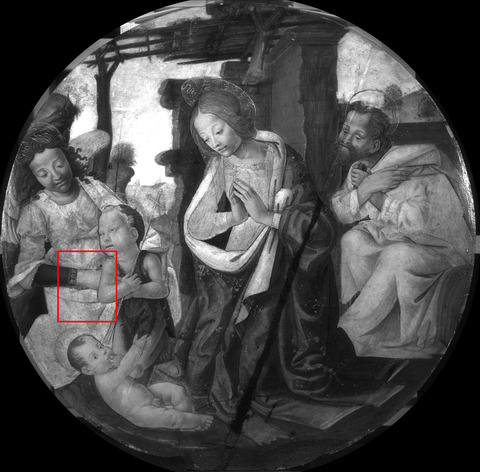
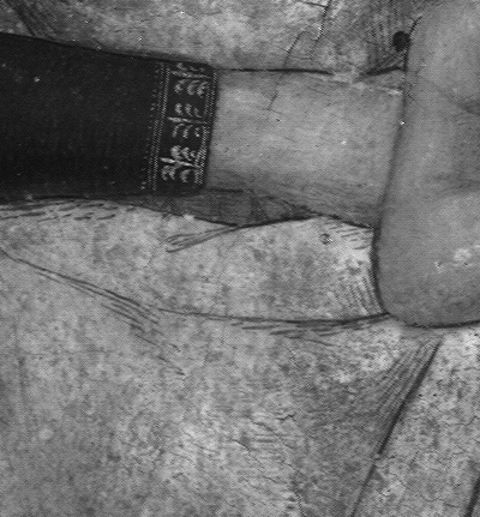
It is likely that the painting was part of a standard set of paintings that a workshop could offer to patrons and was replicated after an already planned composition or planned elements from several compositions that were then rearranged.
Pentimenti:
There appears to have been a stylistic change in the Madonna’s face during the painting stage. The X-radiograph shows the Madonna’s face with full, rosebud lips and round, downturned eyes with heavy eyelids (tech. fig. 11). Her eyes appear to have been slightly lower on her face as well. This style is more consistent with that of the angel on the left side of the panel. The current paint layer does not appear to have been overpainted (although retouching is present) but rather reworked by the artist. This version has upturned eyelids, a wider mouth with thin lips and a square chin (tech. fig. 12).
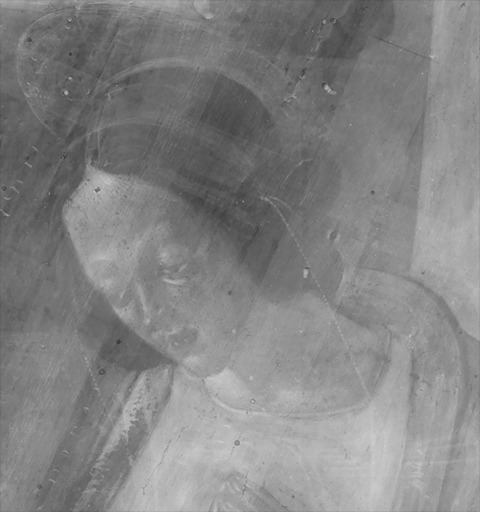
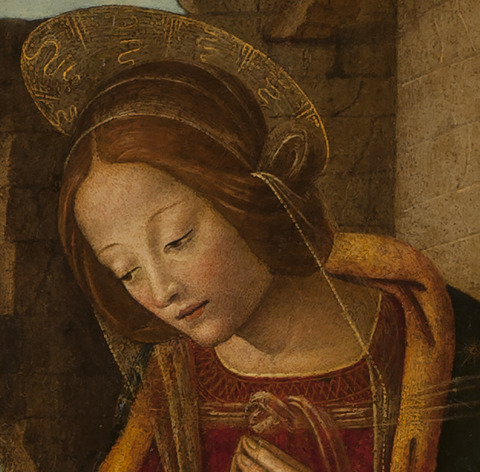
Description of Paint
Analyzed Observed
Application and Technique:
The compromised condition of the painting and heavily retouched surface make it difficult to determine details of the original painting technique. For instance, complex folds of drapery in the Madonna’s robe are visible in the infrared reflectogram (tech. fig. 13), but have been completely obscured by layers of varnish, overpaint, and retouching (tech. fig. 14).
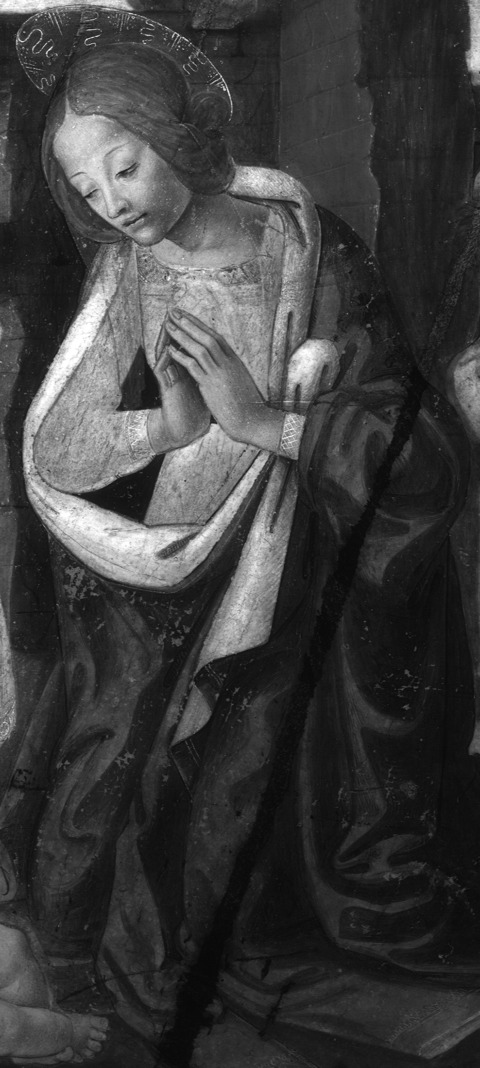
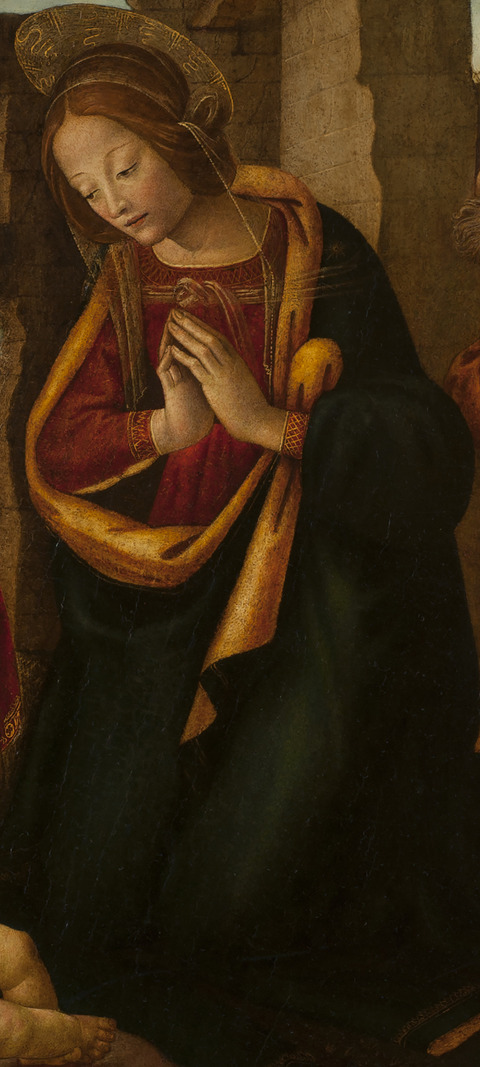
What can be observed of the original painting technique reveals a carefully planned and confidently executed painting, an example of a work that bridges the transition from egg tempera to oil painting. The shadows of the faces are built up over a layer of green verdaccio (tech. fig. 15), typical of early Italian painting technique. The skin tones likely incorporated lake pigments that have faded and become more transparent over time, revealing more of the greenish layer.
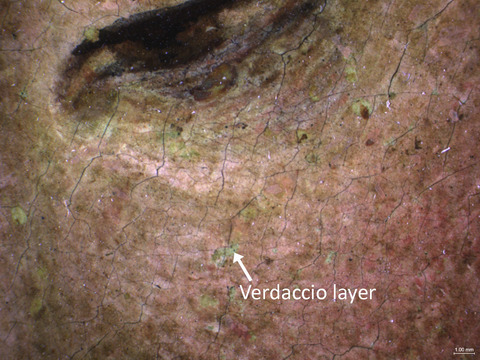
Short, linear brushstrokes, typical of an egg tempera technique, were used to delicately detail the contours of the faces (tech. fig. 16). While most of the faces have endured significant abrasion, the angel’s face shows evidence of the original technique where careful manipulation of small strokes of paint applied highlights, midtones, and shadows over a verdaccio layer to create form. Less restrained brushwork was used in the drapery, suggesting the possible use of oil paint in these areas. Medium analysis would be necessary to confirm this hypothesis, however the current condition of the work, with layers of later paint, makes such analysis difficult.
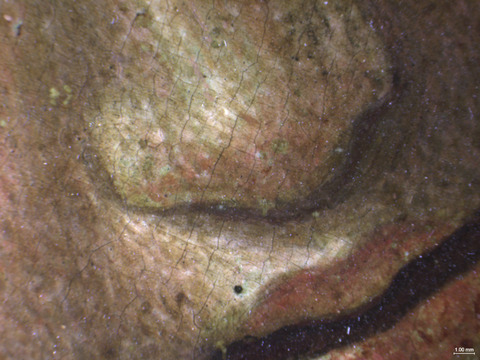
Painting Tools:
Small brushes
Binding Media:
The binder in two samples, one from the face of the Madonna and a second from the red robe of the angel, was analyzed using FTIR. Egg yolk was confirmed as the binder in the face of the Madonna, suggesting the painting was carried out, at least in part, using egg tempera. Due to the presence of an oleo-resinous varnish across the painting, analysis was inconclusive as to whether the red robe was painted with the addition of oil.
Color Palette:
Despite the yellow haze of discolored varnish, the color palette is bright, with prominent use of red, yellows, and blues. XRF analysis combined with SEM-EDS analysis of two cross section samples were used to better understand the artist’s palette.
Lead white was used widely throughout the entire painting. For the skin tones, a mixture of lead white, iron oxide (earth pigments likely including yellow ocher and umber), and vermilion were used likely in addition to organic pigments such as red lake that are not detected by XRF. Azurite was used for the blue tones. SEM-EDS analysis of a cross section from the robe of the Madonna (tech. fig. 17) confirms the presence of copper-containing azurite in this area (tech. fig. 18).

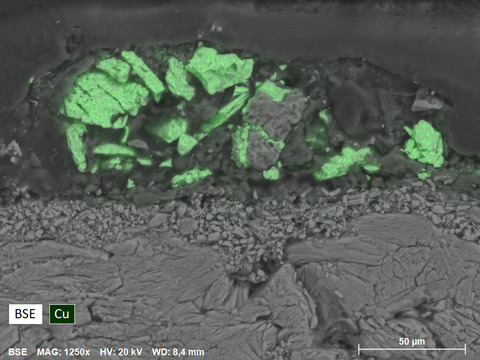
The sky has been repainted several times (see Condition of Paint). Cross section 2 (tech. fig. 19) shows the original paint layer composed of a lead imprimatura (layer 2) followed by a mixture of azurite and lead white (layer 3, tech. fig. 20). Larger passages of red appear to have been painted with red lead or red lake pigments. Umber was also used throughout the painting and particularly in the brown foreground.
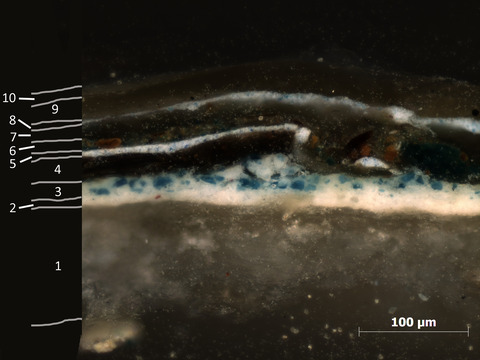
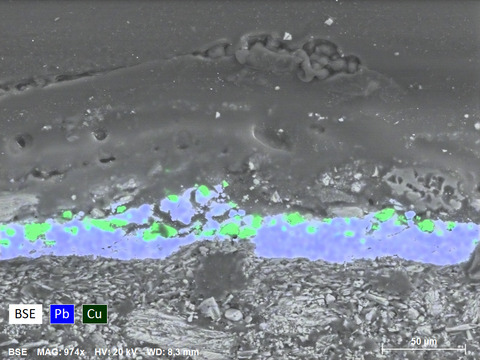
Shell gold was applied in several areas, specifically the halos and decorative elements on the clothes of the Madonna (tech. fig. 21).
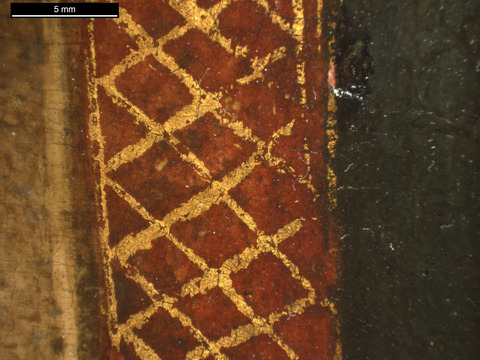
Elemental gold is present in areas of shell gold application in the halos and sleeve, some of which has since been retouched with a gold-like paint that does not contain elemental gold (table 1, sample 9). Some of the gilding was abraded and later repainted with a gold retouching paint, such as in the halo of the Joseph figure (tech. fig. 22).
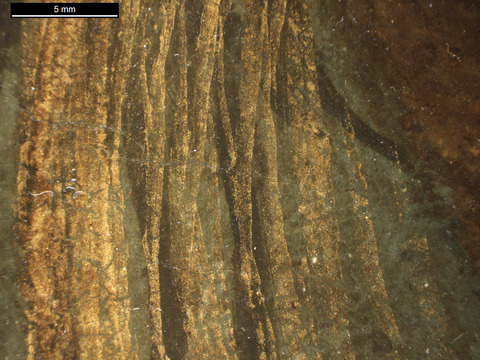
XRF Analysis:
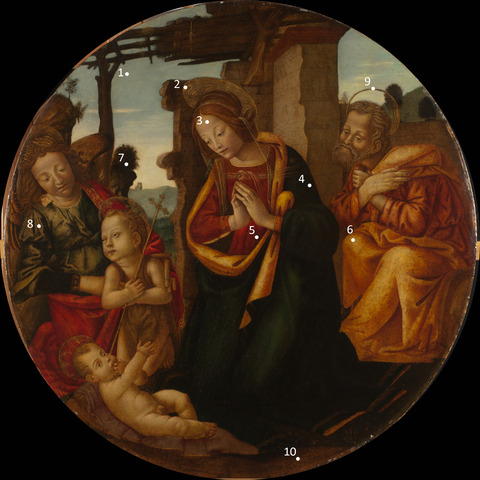
| Sample | Location (x, y) | Elements | Interpretation and Pigments |
|---|---|---|---|
| 1 | Light blue overpaint in the sky, upper left | Major: Pb, Ti, Zn Minor: Ca, Fe Trace: Mn | Lead white, titanium white (from overpaint), zinc white (from overpaint), calcium (from ground layer), iron oxide (earth pigments including umber). |
| 2 | Gold halo, Madonna figure | Major: Pb, Au Minor: Fe, Ca, Cu Trace: K | Lead white, shell gold, iron oxide (earth pigments), calcium (from ground layer), copper-containing blue and or green pigment. |
| 3 | Skin tone, Madonna forehead | Major: Pb Minor: Hg, Fe, Ca Trace: | Lead white, iron oxide (earth pigments), vermilion, calcium (from ground layer). |
| 4 | Dark blue, Madonna robe proper left shoulder | Major: Cu Minor: Pb, Fe Trace: Ca, Mn, K | Azurite, lead white, iron oxide (earth pigments including umber), calcium (from ground layer). |
| 5 | Red in robe, Madonna torso | Major: Pb Minor: Fe, Ca Trace: Mn, Cu, K | Lead white, trace of calcium (from ground layer), trace of iron oxide (earth pigments), possible red lake pigment (not detectable using XRF), possible red lead (not possible to confirm using XRF). |
| 6 | Yellow in Joseph robe by knee | Major: Pb, Cu Minor: Fe, Ca Trace: K | Lead white, copper-containing blue and or green pigment, iron oxide (earth pigments), calcium (from ground layer). |
| 7 | Brown tree | Major: Pb, Fe, Cu, Ca Minor: Hg, Zn Trace: Mn, Ti, K | Lead white, copper-containing green and or blue pigment, iron oxide (earth pigments), calcium (from ground layer), vermilion, zinc white (likely from retouching). |
| 8 | Light blue in robe, angel figure shoulder | Major: Pb Minor: Fe, Ca Trace: Zn, Cu, Mn, K | Lead white, iron oxide (earth pigments including umber), trace of copper-containing green and or blue pigment, trace of zinc white (likely from retouching), calcium (from ground layer). |
| 9 | Gold halo, Joseph figure. | Major: Pb Minor: Fe, Ca Trace: Cu, Hg | Lead white, iron oxide (earth pigments), calcium (from ground layer), trace of copper-containing green and or blue pigment (likely from the original sky layer), trace of vermilion. |
| 10 | Brown in foreground | Major: Fe, Pb Minor: Cu, Hg Trace: Ca | Iron oxide (earth pigments including umber), lead white, vermilion, copper-containing green and or blue pigment. |
Table 1: Results of X-ray fluorescence analysis conducted with a Bruker Artax microfocus XRF with rhodium tube, silicon-drift detector, and polycapillary focusing lens (~100μm spot).
*Major, minor, trace quantities are based on XRF signal strength not quantitative analysis
Surface Appearance:
The paint appears to be relatively thinly applied, with the tempera areas applied in a typical fashion using short, small brushstrokes. There are a few areas of thicker paint where the brushwork and defining lines are slightly raised. There are significant areas of retouching and overpaint visible, which have clearly discolored, leaving an uneven and damaged look to the painting. The paint appears slightly yellow due to discolored varnish over the surface.
Condition of Paint
A micro-cracking pattern related to the natural aging of the paint extends over the entire painting and is particularly evident in the skin tones. There is more significant cracking and old losses in the joins of the panels, which were subsequently filled and retouched. Other areas of loss and abrasion are scattered through the painting and have also been retouched. Much of the areas of glazing have been heavily abraded from a previous cleaning. The paint layer is also abraded along the edges where the painting is in contact with the frame.
It is clear that widespread retouching and overpaint has obscured much of the detail in the original paint layer. The infrared reflectogram of the Madonna’s robe, for example, shows more detailed drapery than appears in the current iteration of the painting (see tech. figs. 13, 14). This could be due to reworking during the painting process, but the heavily restored appearance of the robe suggests numerous campaigns of retouching and overpaint in infrared transparent pigments are a more likely explanation for the flat appearance.
Cross section 2 shows that the sky has been largely repainted several times (tech. fig. 24). Over the original paint layer is a dark layer containing a blue-green particle that is rich in chromium, likely viridian (tech. fig. 25). This suggests the first repainting was applied as early as the second half of the nineteenth century. Two more layers of light blue paint (layers 5, 8) that are rich in titanium (tech. fig. 26) have been applied over this layer, perhaps to “correct” the darker sky with a lighter blue. Titanium white, available by the 1920s, appears to be present in both layers. It is unclear if these layers are from the same overpainting campaign or different campaigns.

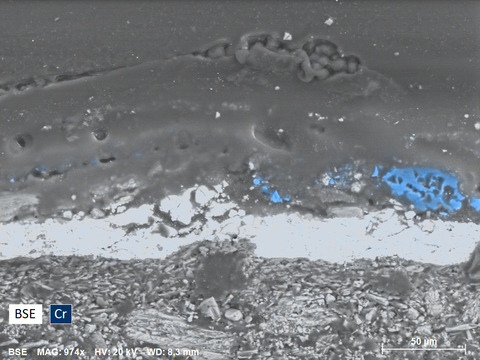
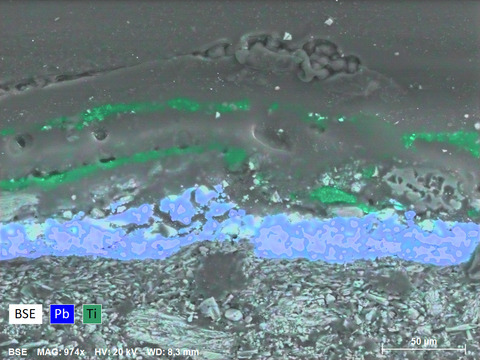
The layers of overpaint were applied using a brushy technique around elements of the foreground and figures, such as Joseph’s halo (tech. fig. 27). The light blue overpaint obscures the original sky layer, which can be seen peeking through (tech. fig. 28). It is unclear why this large-scale overpainting was carried out. The X-radiograph suggests there are several damages in the sky (tech. fig. 1), such as along the panel join, that may have prompted an overly aggressive repainting rather than carefully matching the color of the original layer of aged azurite.
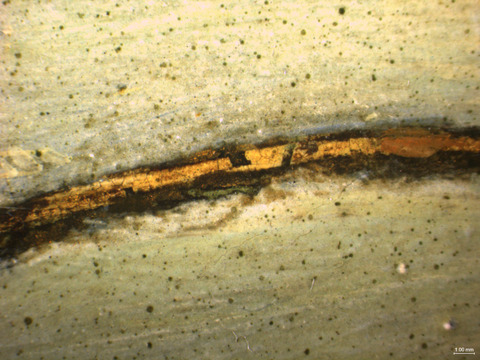
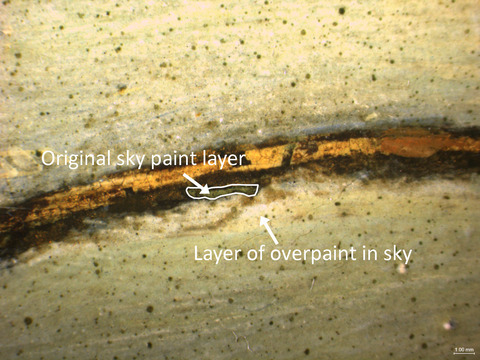
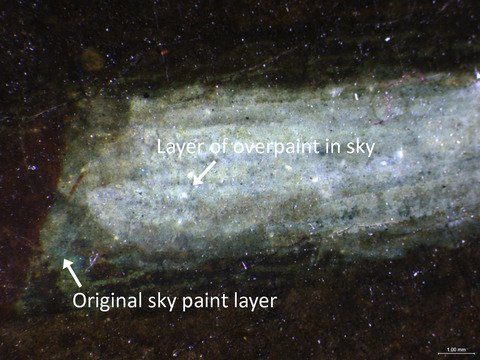
Description of Varnish/Surface Coating
Analyzed Observed Documented
| Type of Varnish | Application |
|---|---|
| Natural resin | Spray applied |
| Synthetic resin/other | Brush applied |
| Multiple Layers observed | Undetermined |
| No coating detected |
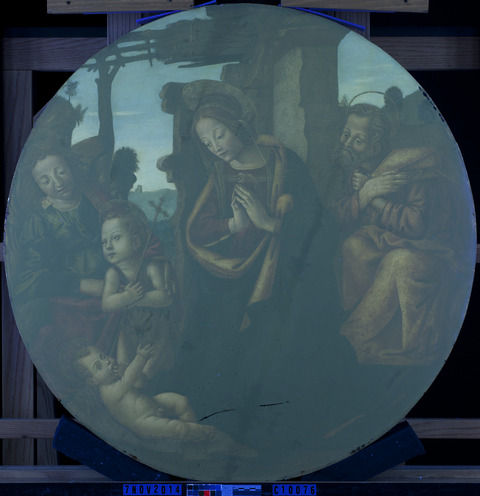
Ultraviolet-induced visible fluorescence reveals a thick coating of discolored varnish present over the surface of the painting (tech. fig. 29). The varnish was analyzed using FTIR, and the upper layer of varnish (tech. fig. 30, layer 10) was found to be a synthetic acrylic resin varnish. The FTIR spectrum from the lower layer of varnish (tech. fig. 30, layer 9) identified linseed oil with the addition of small components of dammar varnish, suggesting the application of an earlier oleo-resinous varnish.
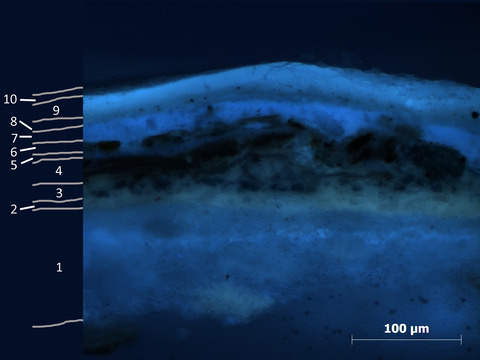
There are several campaigns of retouching and overpaint (see Condition of Paint) present from older restorations including the wholesale repainting of the sky.
Condition of Varnish/Surface Coating
The varnish is thickly applied and discolored, causing the painting to appear severely yellowed (tech. fig. 31). Some areas of the varnish appear matte and hazy, and overall, the varnish no longer adequately saturates the paint layers. Areas of old retouching have discolored with time and are increasingly noticeable as they no longer match the surrounding original paint (tech. fig. 32). The varnish appears to be particularly discolored in the bottom right of the painting, where areas of gilding look brown and details are covered in a yellow-brown coating.
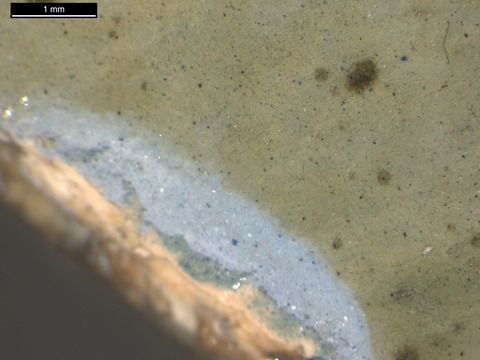
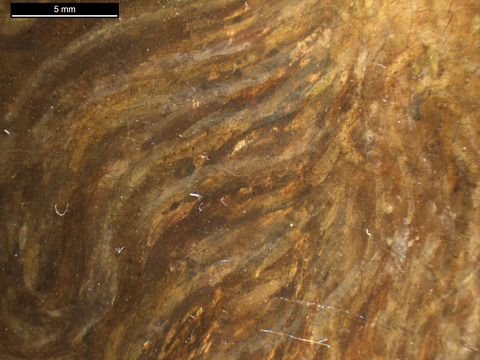
Description of Frame
Original/first frame
Period frame
Authenticity cannot be determined at this time/ further art historical research necessary
Reproduction frame (fabricated in the style of)
Replica frame (copy of an existing period frame)
Modern frame
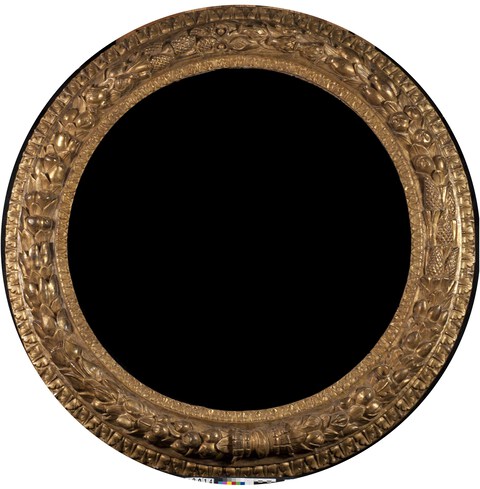
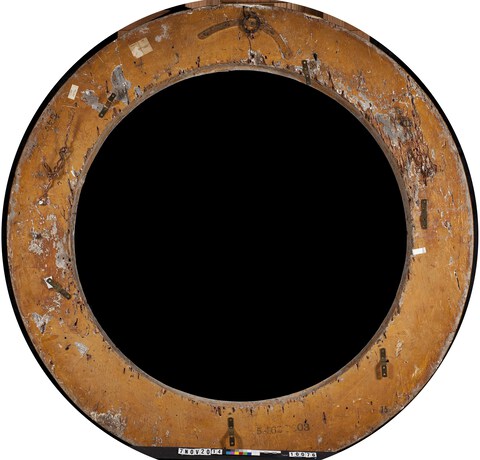
Frame Dimensions:
Outside frame dimensions: 115 cm (diameter)
Sight size: 83 cm (diameter)
Distinguishing Marks:
Item 1. Black stamp (tech. fig. 35).
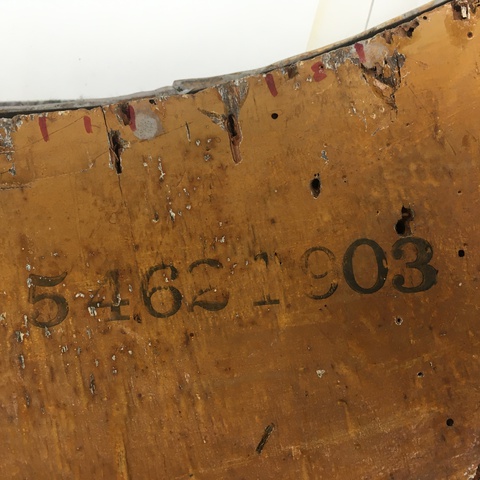
Item 2. Black stamp on brown paper (tech. fig. 36).
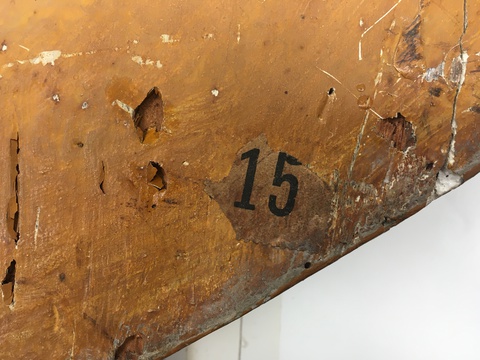
Item 3. Black stamp (tech. fig. 37).
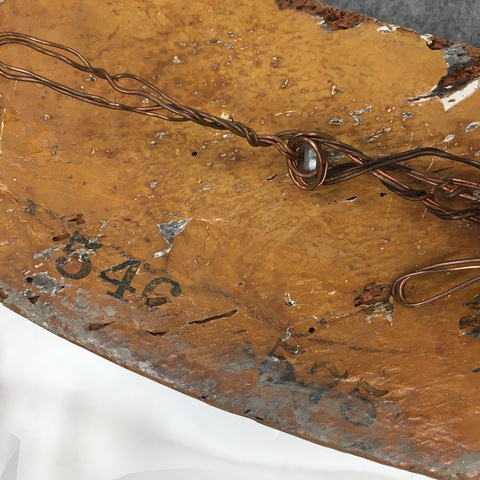
Item 4. White label (tech. fig. 38).
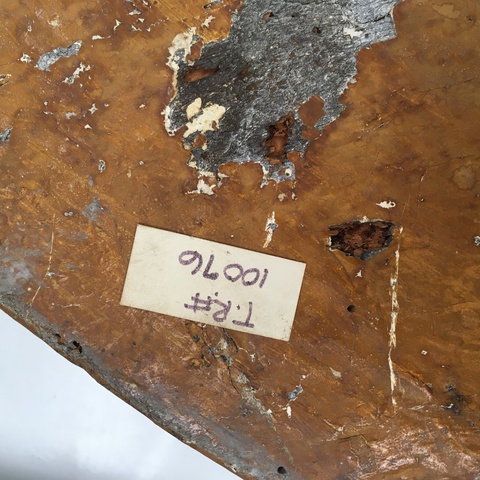
Item 5. White label (tech. fig. 39).
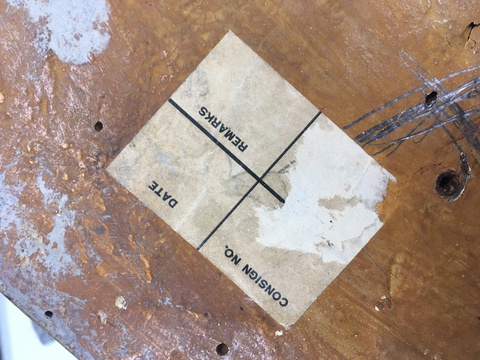
Description of Molding/Profile:
The frame was examined at the IMA by frame specialist Timothy Newbery on 18 January 2012. Newbery suggested that the frame is of Venetian origin and dates from between 1590 and 1600 (tech. fig. 33). It is constructed from poplar and is half-lapped, carved, and gilt. A reddish-orange bole layer is present over the gesso (tech. fig. 33). The top edge has laurel leaves from cross ribbon center to ribbon corners (tech. fig. 40). Star punching is also present on the hollow. The bottom edge portrays a double-twisted ribbon. The frame has been adjusted in the past, including a reduction at the center, and has been backed with a secondary supportive layer of wood (tech. fig. 34).8
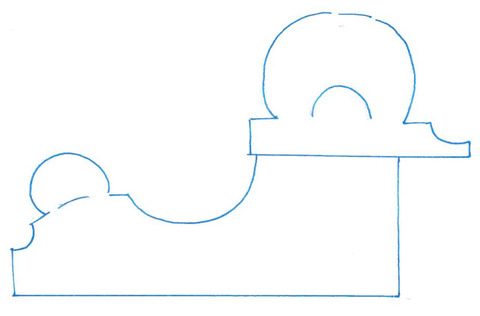
Condition of Frame
The frame is in relatively good condition. It was damaged in the past and restored with some areas of bronze paint visible. The frame needs consolidation since some areas of flaking gesso are present. There is significant woodworm damage, and the channeling is particularly noticeable on the back of the frame, which has since been coated and painted with an orange tone.
Notes
-
Paul A.J. Spheeris, “Conservation Report on the Condition of the Clowes Collection,” 25 October 1971, Conservation Department Files, Indianapolis Museum of Art at Newfields. ↩︎
-
Martin Radecki, Clowes Collection condition assessment, undated (after October 1971), Conservation Department Files, Indianapolis Museum of Art at Newfields. ↩︎
-
Intermuseum Conservation Association, “Clowes Collection Conservation Report,” C10076 (2015.30), 8–10 April 1974, Conservation Department Files, Indianapolis Museum of Art at Newfields. ↩︎
-
Memorandum from Martin Radecki to Bret Waller, “Conservation Work on Clowes Fund Collection,” 16 February 1996, Conservation Department Files, Indianapolis Museum of Art at Newfields. ↩︎
-
Ian Tyers, “Tree-Ring Analysis and Wood Identification of Paintings from the Indianapolis Museum of Art: Dendrochronological Consultancy Report 1082,” January 2019, p. 33, Conservation Department files, Indianapolis Museum of Art at Newfields. ↩︎
-
Cennino Cennini, The Craftsman’s Handbook (Il libro dell’arte), trans. Daniel V. Thompson (New Haven: Yale University Press, 1936), 70–71. ↩︎
-
Elvacite 2040 (synthetic resin) was used to fill the cradle so that its appearance would be minimized in the X-radiograph, allowing the composition to be better interpreted. ↩︎
-
Timothy Newbery, condition report on frame for C10076, 18 January 2012, Conservation Department Files, Indianapolis Museum of Art at Newfields. ↩︎
Additional Images
